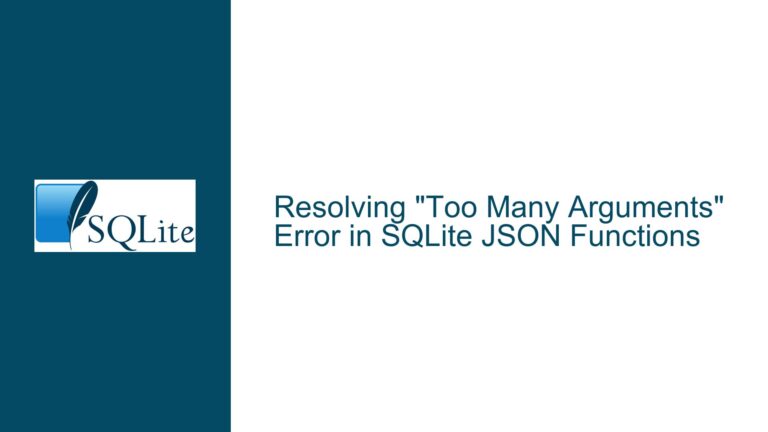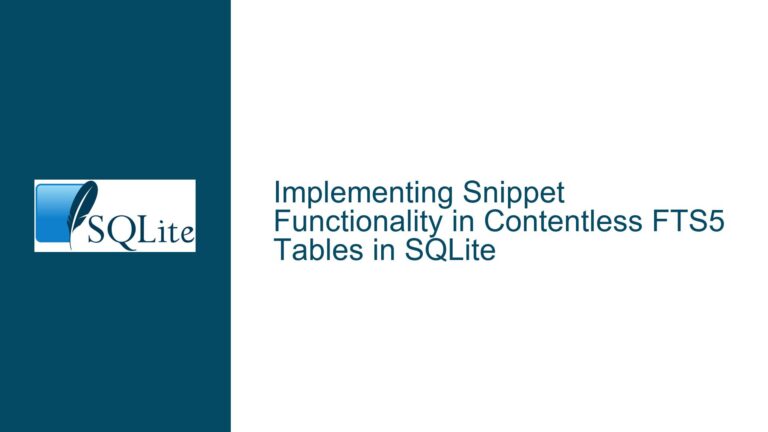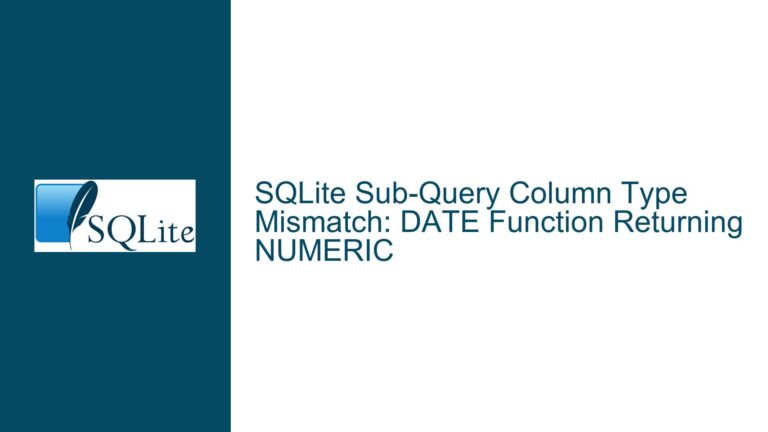SQLite Bug: CTE Visibility Issue with Window Functions
Error: near line 11: no such table: cte_0 During CTE and Window Function Use
The core issue reported is an unexpected error encountered in SQLite when using a Common Table Expression (CTE) in conjunction with a window function. Specifically, SQLite incorrectly reports that the CTE does not exist, even though it is defined within the same query. The error message "Error: near line 11: no such table: cte_0" arises when the query attempts to reference the CTE cte_0 within the OVER clause of the LAG window function. This behavior suggests a bug in how SQLite resolves CTEs within the context of window functions, particularly when the window function’s PARTITION BY clause involves a subquery that attempts to access the CTE. The provided SQL script triggers this error consistently in the affected SQLite versions. This is a critical issue because CTEs are frequently used to simplify complex queries and improve readability, while window functions provide powerful analytical capabilities. The combination of both should work seamlessly, and any failure in their interaction severely limits the expressive power of SQLite for advanced querying. The initial report highlights a test case generated via fuzzing, indicating that the issue was discovered through automated testing, thus suggesting it could potentially impact a wide range of complex SQL statements that combine these features. The fact that the bug was acknowledged and quickly fixed by the SQLite team underscores its significance.
Potential Causes of the CTE Visibility Bug
Several factors could contribute to the observed behavior, leading SQLite to fail to recognize the CTE cte_0 within the window function context.
Scoping Issues: The most likely cause is a scoping problem within the SQLite query parser or execution engine. CTEs have a defined scope—they are typically visible only within the query in which they are defined. However, the window function’s
OVERclause, especially itsPARTITION BYsubclause, might be creating a separate or isolated scope where the CTE is not accessible. This can occur if the query parser incorrectly handles the nested scopes created by the window function’s definition. The parser might be failing to correctly propagate the CTE’s definition into the scope of thePARTITION BYclause’s subquery.Query Plan Optimization: SQLite’s query optimizer could be transforming the original SQL query into an equivalent form that inadvertently breaks the CTE’s visibility. For instance, the optimizer might decide to execute the subquery in the
PARTITION BYclause separately from the rest of the query, thereby losing the context in whichcte_0is defined. The optimizer might also be reordering the execution of different parts of the query in a way that causes the CTE to be referenced before it has been properly defined in the execution plan.Window Function Implementation: The implementation of window functions in SQLite might have inherent limitations or bugs that prevent them from correctly interacting with CTEs. Window functions often require special handling during query parsing and execution, as they involve iterating over sets of rows and applying calculations based on the window frame. If the window function implementation does not properly account for CTEs in its internal logic, it could lead to the observed error. Specifically, the code responsible for resolving table names and references within the window function’s scope might not be correctly traversing the CTE definitions.
Subquery Execution: The subquery within the
PARTITION BYclause (i.e.,(select c1 from cte_0 order by c1 limit 1 offset 4)) could be executed in a way that isolates it from the main query’s CTE context. SQLite might be treating this subquery as an independent query, thereby preventing it from accessing the CTE defined outside of it. This could be due to the way SQLite handles correlated subqueries or subqueries that involveLIMITandOFFSETclauses. The combination of these clauses might be triggering a specific code path that bypasses the CTE’s scope.Parsing Order: The order in which SQLite parses the SQL query could be a factor. If the window function and its
PARTITION BYclause are parsed before the CTE definition is fully processed, SQLite might not be aware of the CTE when it encounters the reference tocte_0within the window function. This could be related to the internal data structures and algorithms used by SQLite to represent and process SQL queries. The parser might be making assumptions about the order in which different parts of the query are defined, and these assumptions could be violated in the presence of CTEs and window functions.Internal Data Structures: The error could stem from how SQLite internally represents table and column names during query processing. If the internal data structures used to store information about tables and columns are not correctly updated or accessed when dealing with CTEs and window functions, it could lead to name resolution failures. For example, the symbol table used by SQLite to track table and column names might not be properly updated when a CTE is defined, or the code responsible for looking up table names might not be correctly searching the symbol table in the presence of nested scopes.
Regression: It is also possible that the bug is a regression introduced in a recent version of SQLite. A regression occurs when a previously working feature is broken due to changes in the code. If the bug was introduced recently, it might be related to optimizations or refactorings performed in the SQLite codebase. Checking the change logs and release notes for recent versions of SQLite might provide clues as to when the bug was introduced and what changes might have caused it.
Interaction with Other Features: The bug might only manifest itself when CTEs and window functions are used in combination with other SQL features, such as triggers, views, or stored procedures. The interaction between these features could be triggering a specific code path that exposes the underlying bug. For example, if the CTE or window function is defined within a trigger, the trigger’s execution context might be interfering with the name resolution process.
Memory Corruption: In rare cases, bugs like this can be caused by memory corruption. If SQLite is incorrectly allocating or managing memory, it could lead to data structures being overwritten or corrupted, resulting in unpredictable behavior. Memory corruption is often difficult to diagnose, as it can manifest itself in different ways depending on the specific circumstances.
Troubleshooting Steps, Solutions, and Fixes
Addressing this SQLite bug requires a systematic approach to identify, isolate, and resolve the underlying cause. Here’s a detailed breakdown of troubleshooting steps, potential solutions, and fixes:
1. Verify the SQLite Version:
- Action: Determine the exact version of SQLite being used.
- Rationale: This is crucial because the bug has been identified and fixed in a specific commit. Knowing the version helps confirm whether the fix is already included or if an upgrade is necessary.
- How: Use the
SELECT sqlite_version();SQL command within the SQLite environment. - Expected Outcome: Obtain the SQLite version number (e.g., "3.35.5"). If the version is older than the fix, proceed to upgrade.
2. Upgrade SQLite:
- Action: Upgrade to the latest stable version of SQLite.
- Rationale: The identified bug has been resolved in a subsequent commit. Upgrading ensures that the fix is applied, eliminating the issue.
- How: The upgrade process depends on the operating system and how SQLite was initially installed.
- Linux (using package manager):
sudo apt-get update sudo apt-get install sqlite3 - macOS (using Homebrew):
brew update brew upgrade sqlite - Windows: Download the latest precompiled binaries from the SQLite website and replace the existing SQLite DLLs.
- Linux (using package manager):
- Expected Outcome: The SQLite version should be updated to the latest stable release, which includes the bug fix. After the upgrade, re-run the original SQL script to verify that the error is resolved.
3. Simplify the SQL Query:
- Action: Reduce the complexity of the SQL query to isolate the problematic components.
- Rationale: By simplifying the query, it becomes easier to pinpoint the exact combination of features that triggers the bug. This helps confirm that the issue is indeed related to the interaction between CTEs and window functions.
- How:
- Remove the
LAGfunction and theOVERclause entirely. Does the query work then? - Remove the
PARTITION BYclause from theOVERclause. - Remove the
ORDER BYclause from the subquery within thePARTITION BYclause. - Remove the
LIMITandOFFSETclauses from the subquery. - Replace the CTE with a temporary table.
- Replace the window function with a subquery or a join.
- Remove the
- Expected Outcome: Identify the minimal SQL query that still exhibits the bug. This provides a focused test case for further investigation.
4. Examine Query Plans:
- Action: Analyze the query execution plan generated by SQLite.
- Rationale: The query plan reveals how SQLite intends to execute the query, including the order in which tables are accessed, indexes are used, and operations are performed. Examining the query plan can help identify potential inefficiencies or incorrect transformations that might be contributing to the bug.
- How: Use the
EXPLAIN QUERY PLANcommand before the SQL query.EXPLAIN QUERY PLAN WITH cte_0 AS ( SELECT ref_0.c_muyat AS c1 FROM t_sa AS ref_0 ) SELECT LAG(CAST(CAST(NULL AS INTEGER) AS INTEGER)) OVER gen8fjew AS c0 FROM t_sa AS ref_5 WINDOW gen8fjew AS ( PARTITION BY ( SELECT c1 FROM cte_0 ORDER BY c1 LIMIT 1 OFFSET 4 ) ); - Expected Outcome: A detailed description of the query plan, showing how SQLite intends to execute the query. Look for any unusual or unexpected steps, such as full table scans, unnecessary sorting operations, or incorrect index usage. Pay close attention to how the CTE and the window function are handled in the query plan.
5. Test with Different Data:
- Action: Populate the
t_satable with different sets of data and observe if the bug persists. - Rationale: Certain data patterns or value ranges might be exacerbating the issue. Testing with diverse data helps uncover data-dependent behavior and potential edge cases.
- How: Insert various combinations of integer and text values into the
c_muyat,c_d4u,c_lngdt, andc_c3vcolumns of thet_satable. Include null values, empty strings, large integers, and special characters. - Expected Outcome: Determine if the bug is consistently reproducible across different datasets or if it only occurs with specific data patterns. If the bug is data-dependent, it suggests that the issue might be related to how SQLite handles certain data types or values within the CTE and window function context.
6. Review the SQLite Source Code (Advanced):
- Action: Examine the SQLite source code, specifically the sections related to CTE processing, window function implementation, and query plan optimization.
- Rationale: This is a more advanced step that requires familiarity with the SQLite codebase. By reviewing the source code, it might be possible to identify the exact location where the bug is occurring and understand the underlying logic that is causing the issue.
- How: Download the SQLite source code from the SQLite website. Use a code editor or IDE to navigate the codebase and examine the relevant files.
- Expected Outcome: A deeper understanding of how SQLite handles CTEs and window functions internally. This can help pinpoint the root cause of the bug and develop a more targeted solution.
7. Workarounds (If Upgrade Is Not Immediately Possible):
- Action: If upgrading SQLite is not immediately feasible, consider alternative query structures or techniques to achieve the desired result without triggering the bug.
- Rationale: Workarounds provide temporary solutions to bypass the bug while waiting for a proper fix.
- Possible Workarounds:
- Replace the CTE with a temporary table: Create a temporary table to store the results of the CTE query. Then, reference the temporary table in the main query instead of the CTE.
CREATE TEMPORARY TABLE temp_cte AS SELECT ref_0.c_muyat AS c1 FROM t_sa AS ref_0; SELECT LAG(CAST(CAST(NULL AS INTEGER) AS INTEGER)) OVER gen8fjew AS c0 FROM t_sa AS ref_5 WINDOW gen8fjew AS ( PARTITION BY ( SELECT c1 FROM temp_cte ORDER BY c1 LIMIT 1 OFFSET 4 ) ); - Rewrite the query without using a window function: Use subqueries or joins to achieve the same result as the window function. This might involve more complex SQL, but it can avoid the bug.
SELECT ( SELECT LAG(c_muyat) OVER (ORDER BY c_muyat) FROM ( SELECT ref_5.c_muyat, ( SELECT c1 FROM ( SELECT ref_0.c_muyat AS c1 FROM t_sa AS ref_0 ) AS cte_0 ORDER BY c1 LIMIT 1 OFFSET 4 ) AS partition_col FROM t_sa AS ref_5 ) AS subquery WHERE subquery.partition_col = ( SELECT c1 FROM ( SELECT ref_0.c_muyat AS c1 FROM t_sa AS ref_0 ) AS cte_0 ORDER BY c1 LIMIT 1 OFFSET 4 ) ) AS c0 FROM t_sa AS ref_5; - Use a subquery instead of a CTE: Inline the CTE query as a subquery directly within the main query. This can sometimes avoid the scoping issues that cause the bug.
SELECT LAG(CAST(CAST(NULL AS INTEGER) AS INTEGER)) OVER gen8fjew AS c0 FROM t_sa AS ref_5 WINDOW gen8fjew AS ( PARTITION BY ( SELECT c1 FROM ( SELECT ref_0.c_muyat AS c1 FROM t_sa AS ref_0 ) AS cte_0 ORDER BY c1 LIMIT 1 OFFSET 4 ) );
- Replace the CTE with a temporary table: Create a temporary table to store the results of the CTE query. Then, reference the temporary table in the main query instead of the CTE.
- Expected Outcome: A functional workaround that allows the desired query to be executed without encountering the bug. Keep in mind that workarounds might have performance implications or require more complex SQL.
8. Provide Feedback to the SQLite Team:
- Action: If the bug persists even after upgrading to the latest version or if a suitable workaround cannot be found, report the issue to the SQLite development team.
- Rationale: Reporting the bug helps the SQLite team become aware of the issue and prioritize it for future fixes.
- How: Visit the SQLite website and follow the instructions for reporting bugs. Provide a detailed description of the issue, including the SQL query, the SQLite version, the steps to reproduce the bug, and any relevant error messages.
- Expected Outcome: Confirmation from the SQLite team that the bug has been reported and is being investigated. This helps ensure that the issue will be addressed in a future release of SQLite.
9. Fuzzing and Automated Testing:
- Action: Integrate the problematic SQL query into a fuzzing or automated testing suite.
- Rationale: Automated testing helps ensure that the bug does not reappear in future versions of SQLite. Fuzzing involves generating a large number of random SQL queries to uncover unexpected behavior and potential vulnerabilities.
- How: Use a fuzzing tool or a testing framework to execute the SQL query repeatedly with different variations and data inputs. Monitor the results for errors or unexpected behavior.
- Expected Outcome: Increased confidence in the stability and reliability of SQLite. Automated testing helps prevent regressions and ensures that the bug remains fixed in future releases.
By following these troubleshooting steps, solutions, and fixes, it should be possible to effectively address the SQLite bug related to CTE visibility within window functions. Remember to always verify the SQLite version, upgrade to the latest release, simplify the SQL query, examine query plans, test with different data, and consider workarounds if necessary. If the bug persists, report it to the SQLite team and integrate the problematic query into an automated testing suite.






